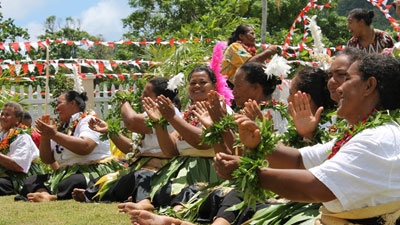Nuku ‘Alofa, Tonga, Dec 27, 2012 - Cyclone Evan is a poignant reminder of the extreme vulnerability of Pacific Island Countries to natural disasters. It comes just three years after a major tsunami which caused significant damage across the South Pacific, killing nearly 200 people.
In September 2009, the same tsunami reached the coast of Niuatoputapu, one of Tonga’s outermost islands close to the Samoan border. It tore through people’s homes and destroyed everything they had. Tragically, nine people lost their lives.
The impacts on the community have been profound. Everyone remembers where they were and what they were doing when the tsunami struck - the moment when they realized something was wrong.
“We were living in the main town close to the shoreline,” said Kueva Losalu, who lives with her husband and their two young grandchildren. “I was fixing the girls’ hair as they were getting ready for school, then I felt the ground shake. I’ve never felt anything like that. I said ‘Run!’, and looked back and saw the wave coming. Nobody had ever dreamed of a tsunami before.”
There weren’t many vehicles to take people to the highlands, where it was safe from the engulfing spread of the tsunami. People ran, but some were left behind. “One older person went back – people do not know why. He said he had forgotten something,” a community member recalls.
Fe’ao Vakata is from Niuatoputapu. Now Member of Parliament for the Niuas constituency, he came over as part of one of the first relief teams, bringing clothes and other urgent supplies to the affected communities.
“From wharf to shore you could see damage and there was no-one around. It was like a ghost-town. There was no house that wasn’t affected. All the houses on the right-hand side were gone.”
“The community was devastated. You talked to them at the time and everyone cried, even the men. They said it’s not just the wave but the whole sea that came to us. The week after it happened, people refused to come down from the mountain. They stayed in the bush, too scared that another disaster might strike.”
The World Bank is helping to protect communities from future disasters
Now in Niuatoputapu things look very different. There is a new school for the island’s children; roads have been repaired, and villages have been reconnected to critical water supplies. The World Bank has helped the Government build new cyclone-proofed houses for communities on elevated land, where it is less vulnerable to natural disasters.
The official opening of the houses was an emotional experience, and a time of celebration. But rebuilding after a disaster is never only about the physical infrastructure. It is about healing, making sure people can feel secure and hopeful for the future.
Pesi Hoa is staying with her family in one of the new houses, built under the first part of the project. Visiting after a long time, she described how things feel different now.
“People are still very traumatized by what happened. If there’s a big noise they are frightened. When there was a tsunami warning as far away as Japan, people fled up the mountain. They don’t want to unpack their things in the normal way – they’re leaving things in plastic.
“Things are getting better. We are looking down at the sea now, people can see it’s a bit further away, and the mountain is a bit closer. People are starting to plant trees and put up fences, to make it feel like home.”
It will take time, years even, before people can feel completely at ease, but the new houses symbolize a new beginning. “The project is about much more than a number,” said Fe’ao. “It is about the joy and happiness of the people.”
The Pacific is one of the most disaster-prone region in the world, with many island communities vulnerable to the potentially tragic effects of cyclones, tsunamis, volcanic eruptions and other natural disasters. In Tonga and other Pacific Island nations, the World Bank is working with partners, governments and local people to not only build back in the immediate aftermath of a disaster, but also to better protect communities for the future.
Helping governments act today to prepare for tomorrow is a major focus for the World Bank across the region, to help avert some of the worst social and economic losses a disaster can bring. It will remain critical to the work of the World Bank in the Pacific in the years ahead.
Uini Limoni has her granddaughter on her lap and she looks at her, with tears in her eyes. “The families are safer now, the children are safe. How can we not be thankful for that.”

